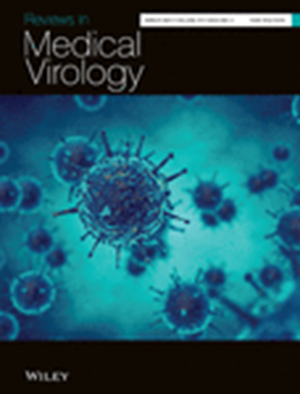Prevalence and outcomes of upper gastrointestinal bleeding in COVID-19: A systematic review and meta-analysis
IF 9
2区 医学
Q1 VIROLOGY
引用次数: 0
Abstract
Upper gastrointestinal bleeding (UGIB) in COVID-19 presents challenges in patient management. Existing studies lack comprehensive review due to varied designs, samples, and demographics. A meta-analysis can provide valuable insights into the incidence, features, and outcomes of UGIB in COVID-19. A comprehensive literature search was carried out using several databases. We considered all appropriate observational studies from all over the world. Mantel-Haenszel odds ratios and associated 95% confidence intervals (CIs) were produced to report the overall effect size using random effect models. Besides, Random effects models were used to calculate the overall pooled prevalence. Funnel plots, Egger regression tests, and Begg-Mazumdar's rank correlation test were used to appraise publication bias. Data from 21 articles consisting of 26,933 COVID-19 patients were considered. The pooled estimate of UGIB prevalence in patients admitted with COVID-19 across studies was 2.10% (95% CI, 1.23–3.13). Similarly, the overall pooled estimate for severity, mortality, and rebleeding in COVID-19 patients with UGIB was 55% (95% CI, 37.01–72.68), 29% (95% CI, 19.26–40.20) and 12.7% (95% CI, 7.88–18.42) respectively. Further, UGIB in COVID-19 patients was associated with increased odds of severity (OR = 3.52, 95% CI 1.80–6.88, P = 0.001) and mortality (OR = 2.16, 95% CI 1.33–3.51, P = 0.002) compared with patients without UGIB. No significant publication bias was evident in the meta-analysis. The results of our study indicate that UGIB in individuals with COVID-19 is linked to negative outcomes such as severe illness, higher mortality rates, and an increased risk of re-bleeding. These findings highlight the significance of identifying UGIB as a significant complication in COVID-19 cases and emphasise the importance of timely clinical assessment and proper treatment.COVID-19 中上消化道出血的发生率和结果:系统回顾和荟萃分析
COVID-19 中的上消化道出血(UGIB)给患者管理带来了挑战。由于设计、样本和人口统计学方面的差异,现有研究缺乏全面回顾。荟萃分析可为了解 COVID-19 中 UGIB 的发病率、特征和预后提供有价值的见解。我们使用多个数据库进行了全面的文献检索。我们考虑了世界各地所有适当的观察性研究。利用随机效应模型生成了曼特尔-海恩泽尔几率比率和相关的 95% 置信区间 (CI),以报告总体效应大小。此外,随机效应模型还用于计算总的集合流行率。漏斗图、Egger回归检验和Begg-Mazumdar秩相关检验用于评估发表偏倚。研究考虑了来自 21 篇文章、26,933 名 COVID-19 患者的数据。在所有研究中,COVID-19 患者 UGIB 患病率的汇总估计值为 2.10%(95% CI,1.23-3.13)。同样,COVID-19 患者 UGIB 的严重程度、死亡率和再出血的总体汇总估计值分别为 55%(95% CI,37.01-72.68)、29%(95% CI,19.26-40.20)和 12.7%(95% CI,7.88-18.42)。此外,与没有 UGIB 的患者相比,COVID-19 患者的 UGIB 与严重程度(OR = 3.52,95% CI 1.80-6.88,P = 0.001)和死亡率(OR = 2.16,95% CI 1.33-3.51,P = 0.002)增加的几率相关。荟萃分析未发现明显的发表偏倚。我们的研究结果表明,COVID-19 患者的 UGIB 与严重疾病、较高死亡率和再出血风险增加等不良后果有关。这些研究结果突显了将 UGIB 识别为 COVID-19 病例中重要并发症的重要性,并强调了及时进行临床评估和适当治疗的重要性。
本文章由计算机程序翻译,如有差异,请以英文原文为准。
求助全文
约1分钟内获得全文
求助全文
来源期刊

Reviews in Medical Virology
医学-病毒学
CiteScore
21.40
自引率
0.90%
发文量
88
期刊介绍:
Reviews in Medical Virology aims to provide articles reviewing conceptual or technological advances in diverse areas of virology. The journal covers topics such as molecular biology, cell biology, replication, pathogenesis, immunology, immunization, epidemiology, diagnosis, treatment of viruses of medical importance, and COVID-19 research. The journal has an Impact Factor of 6.989 for the year 2020.
The readership of the journal includes clinicians, virologists, medical microbiologists, molecular biologists, infectious disease specialists, and immunologists. Reviews in Medical Virology is indexed and abstracted in databases such as CABI, Abstracts in Anthropology, ProQuest, Embase, MEDLINE/PubMed, ProQuest Central K-494, SCOPUS, and Web of Science et,al.
 求助内容:
求助内容: 应助结果提醒方式:
应助结果提醒方式:


